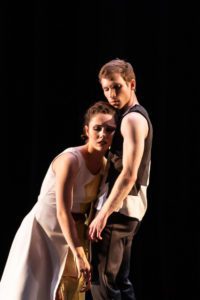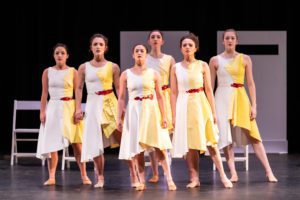Grace and Grit: 72 Steps
Voting and ballet don’t appear to have much in common, other than they are acts performed by humans; but the Nashville Ballet has set out to challenge that idea. 72 Steps, a new ballet choreographed by Gina Patterson and performed by the Nashville Ballet’s second company, NB2, premiered last Saturday at Harpeth Hall’s Frances Bond Davis Theater to a packed house and riveted audience.

The new ballet depicts the struggles leading up to the passage of the 19th Amendment in the Tennessee House of Representatives, which made Tennessee the 36th state to give women the right to vote, and triggered national ratification. While this may sound like an odd topic for a ballet, it was an effective and moving medium to tell a story of perseverance, change, and upheaval. The title of the ballet, 72 Steps, is meant to both represent the number of stairs women had to climb to reach the Tennessee State Capitol building to hear the outcome of the vote by the House of Representatives, and the number of years women spent working towards suffrage.
Patterson’s choreography is modern and fluid, with dancers assuming rolls and blending back into the corps de ballet seamlessly. Some of the choreography was direct, telegraphing an emotion or intent, such as a male dancer pressing down on a female dancer’s head while she attempted to climb imaginary stairs, sinking lower and lower until she was lying on the floor. Another powerful movement set was a line of women dancers holding their hands over their own mouths; one by one the dancer to the right would pull the hands away from the dancer on the left, figuratively freeing her voice. The dancing itself was superb. All eight members of the cast were electrifying performers, and in the brief moments where lines were spoken each voice was clear and distinct.
The ballet was structured in loose vignettes; some scenes took place on the steps of the Capitol building, while others were in more intimate spaces. As far as a narrative, the two clear characters in the piece were Harry T. Burn, a young member of the Tennessee House of Representatives, and Febb Ensminger Burn, his mother. The two danced a beautiful and unconventional pas de deux toward the end of the ballet, with Febb lifting and pirouetting Harry in a way that flipped the gender stereotypes of the dance. This helped to illustrate the nurturing strength of Febb and Harry’s youth. Shortly thereafter, Harry read from a letter he received from his mother, in which she implored him to vote for suffrage.
One of the most striking aspects of the ballet was the costume design. Jocelyn Melenchincky designed simple shift-style dresses for the women, and frock coats for the men. The frock coats came to represent power, dominance, and anti-suffrage sentiment, and at various points in the choreography both male and female dancers whipped the coats on and off to create feelings of menace, conflict, or longing. The two pas de deux in the piece both featured men without their coats, transforming them into sensitive and vulnerable beings. Another important aspect of the costume design was a dress form on wheels, sporting a long starched white dress. At different points of the piece dancers- men and women both- would take turns sliding inside the dress form and walking soberly across the stage. According to Patterson in a Q&A afterwards, the dress on the dress form represented the history and tradition of conventional women’s roles, and the hope that these roles could adapt and move into the future without severing the connection to their past.

The score of 72 Steps was composed by Nashville composer Jordan Brooke Hamlin, who mentioned in her section of the Q&A that this was her first collaboration with dancers. While the expectation going in might have been for period music of the 1920’s, Hamlin opted (with great success) for a hybrid of acoustic and synthesized sounds which were at times hypnotic and tribal. The emotional core of her work centered on recurring cello solos, gorgeous lines that floated over a percussive background. Hamlin’s experience as a french horn player showed itself in her deft handling of a brass fanfare motif that appeared during moments of conflict or high excitement.
The League of Women Voters commissioned this work with the hope that it will be performed across the state in conjunction with the middle school history curriculum. This ballet will surely bring history alive for young students, as many of the issues addressed are ones we are still wrestling with today as a society. When a piece of art can educate, inspire, entertain, and open the door for discovery, it is the most vital kind of art. 72 Steps does all of the above, with grace and grit.
- About the Author
- Latest Posts
Sarah Wilfong Joblin is a fiddle player, session string arranger, and Suzuki certified violin educator based in Nashville, TN. She is currently pursuing her Master’s of Music in Violin Performance at Middle Tennessee State University. Sarah has released two solo albums of original and traditional fiddle music, and her playing and arrangements have been featured on numerous other recordings, the most notable being a recently discovered and posthumously released track, “The Way is Love”, by Roy Orbison on the 25th anniversary re-release of his iconic album Mystery Girl. When not being involved in all things musical, Sarah spends her time chasing after her two young daughters, and watching Star Trek reruns.



